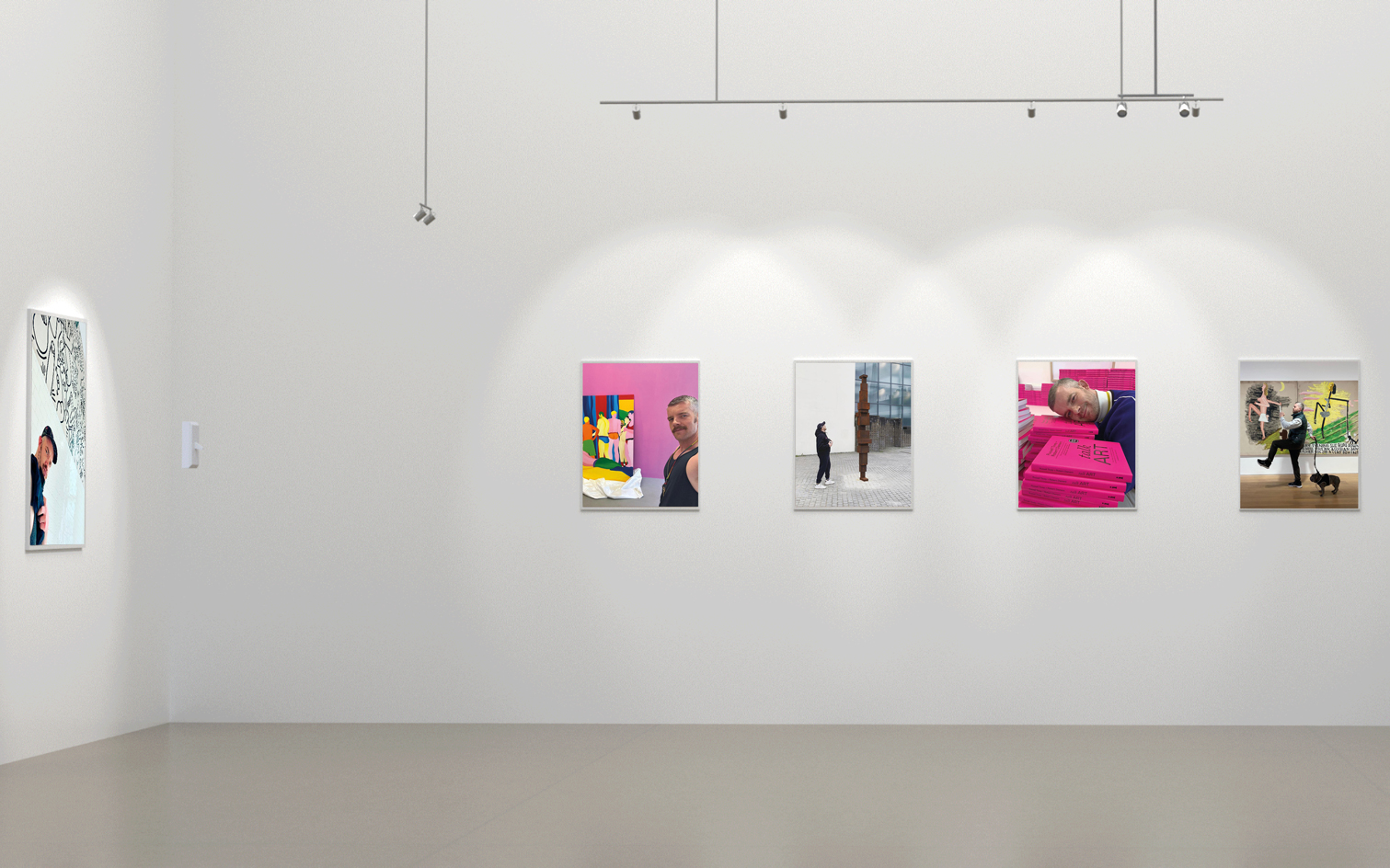
Russell Tovey's ascent in the art world has been meteoric, which might have something to do with his remarkable career as an actor and the celebrity this entails. But it only takes minutes of conversation to realise his infectious enthusiasm for art, his impressive grasp of art history, and his generous championing of emerging talents, which have surely played a more important role in his popularity among artists, institutions and audiences alike.
He has curated an arts festival for the English seaside town of Margate, organised exhibitions with illustrious galleries (among them David Zwirner), put his personal art collection on view at London’s The Perimeter, and served on the judging panel of the 2021 Turner Prize. His much-lauded Talk Art podcast series, a collaboration with gallerist and long-time friend Robert Diament, is now in its 13th season, with recent guests including Tracey Emin, Sonia Boyce and Hew Locke. The accompanying Talk Art book, published last May, is a best-seller and boasts a foreword by none other than Jerry Saltz, arguably the most influential art critic of our time.
Tovey’s latest curatorial collaboration has been with artist Navot Miller, for whom he has curated solo shows in London and now New York (at 1969 Gallery on the Lower East Side, until 28 July). Captivating, exuberant and proudly queer, Miller’s output seems to embody the kind of art Tovey is fondest of. As Tovey writes evocatively in the exhibition introduction, ‘it’s as if David Hockney and Patrick Caulfield met and birthed [Miller] on the dance floor of a sweaty nightclub in Berlin (where the artist lives and works); midwifed into a second term by Ken Price and reaching full term – pulled into the world giggling, spinning, sparkling and twinkling through the efforts of Keith Haring and Andy Warhol’.
As part of our ‘At home with’ interview series, we catch up with Tovey – usually London-based, but currently in New York to film an as yet unannounced TV series – on his projects with Miller, the joys of being part of an artist’s journey, evolving public attitudes towards queer art, the podcast guests on his wish list, his dream curatorial assignment, and his favourite art institution in the world (hint: his love of dogs factors into the decision).

Tovey pictured with a work by Berlin-based artist Navot Miller
Wallpaper*: Where are you at the moment?
Russell Tovey: I’m in New York for the summer, doing a TV show. The last time I was here, I was doing an Edward Albee play on Broadway, called Who’s Afraid of Virginia Woolf? We did eight previews and then it got shut down because of Covid, and I haven’t been back since. I love this city, and I was coming back this time with slight trepidation. But actually, the city feels completely alive again. And obviously, the art scene is just the best. I’m an art nut, and I’ve been able to see a lot of shows, go to the Whitney Biennial and to MoMA, and then all the galleries in Chelsea. I’m very happy here.
W*: What can you tell us about the latest show you have curated, with artist Navot Miller?
RT: You’ll never meet anyone like Navot Miller. He’s kooky, unique, brilliant, flamboyant, and proudly queer. His work is about the connections between us. With what we’ve all been through, being kept apart from one another because of the virus, it’s great to see work that’s a celebration of connection, whether that be a one-night-stand, a dear friend, a regular lover, or a family member. It’s full of joy and love, and with a flash of Keith Haring.
I met Navot through a friend of mine. We went to the Tate together, and we instantly clicked. And then Rob [Diament] and I invited him to come on to Talk Art. That’s when I started to get closer to him on a curatorial level.
Receive our daily digest of inspiration, escapism and design stories from around the world direct to your inbox.
The exhibition is at 1969 Gallery, on the Lower East Side. It follows on from a show that I did with Navot in London, at Grove Collective. Around that time, he said to me that his dream was to have an exhibition in New York, so I took his work to Quang Bao [owner of 1969 Gallery] and said, I really want to do a solo in your space with this guy. These shows are hopefully among many things Navot and I are going to do together.
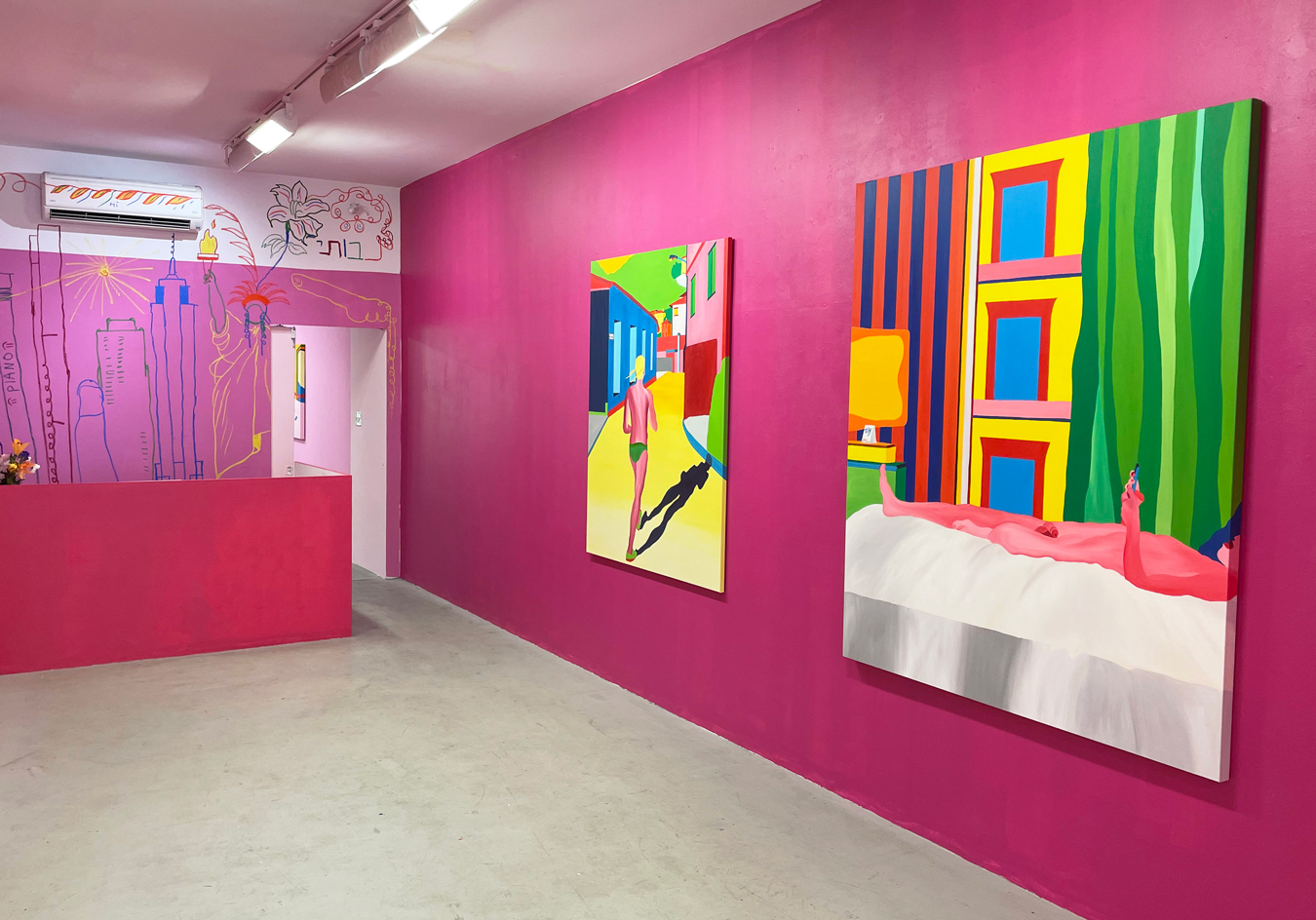
Installation view of 'Coming Back Homo', by Navot Miller. Courtesy of the artist and 1969 Gallery
W:* The title of the show is ‘Coming Back Homo’. Can you tell us about the conversations around the theme, and how the two of you worked together to decide on the artworks?
RT: ‘Coming Back Homo’ is very personal to Navot. He has family members who are from the States, so it’s like a homecoming. It's a love letter to New York, saying, you have been my aspiration, and here I am.
He’s one of those guys who is really incredibly passionate and talented, and excited about life. He’s made seven paintings for the show. I asked him to do some wall drawings too, and he responded with a big yes. He brought all of his oil sticks and just started drawing on the walls while I was hanging the paintings. I said, ‘there’s a gap here, and I want you to take up the space.’ And he went at it.
There’s also one of his films. He makes these by splicing together his own video clips with sound – whether it’s music, a voice note someone sent him, or something he’s overheard – they feel very nostalgic, very pop and true to him. They make me love my friends more. They make me appreciate my life more. And they make me want to travel more.
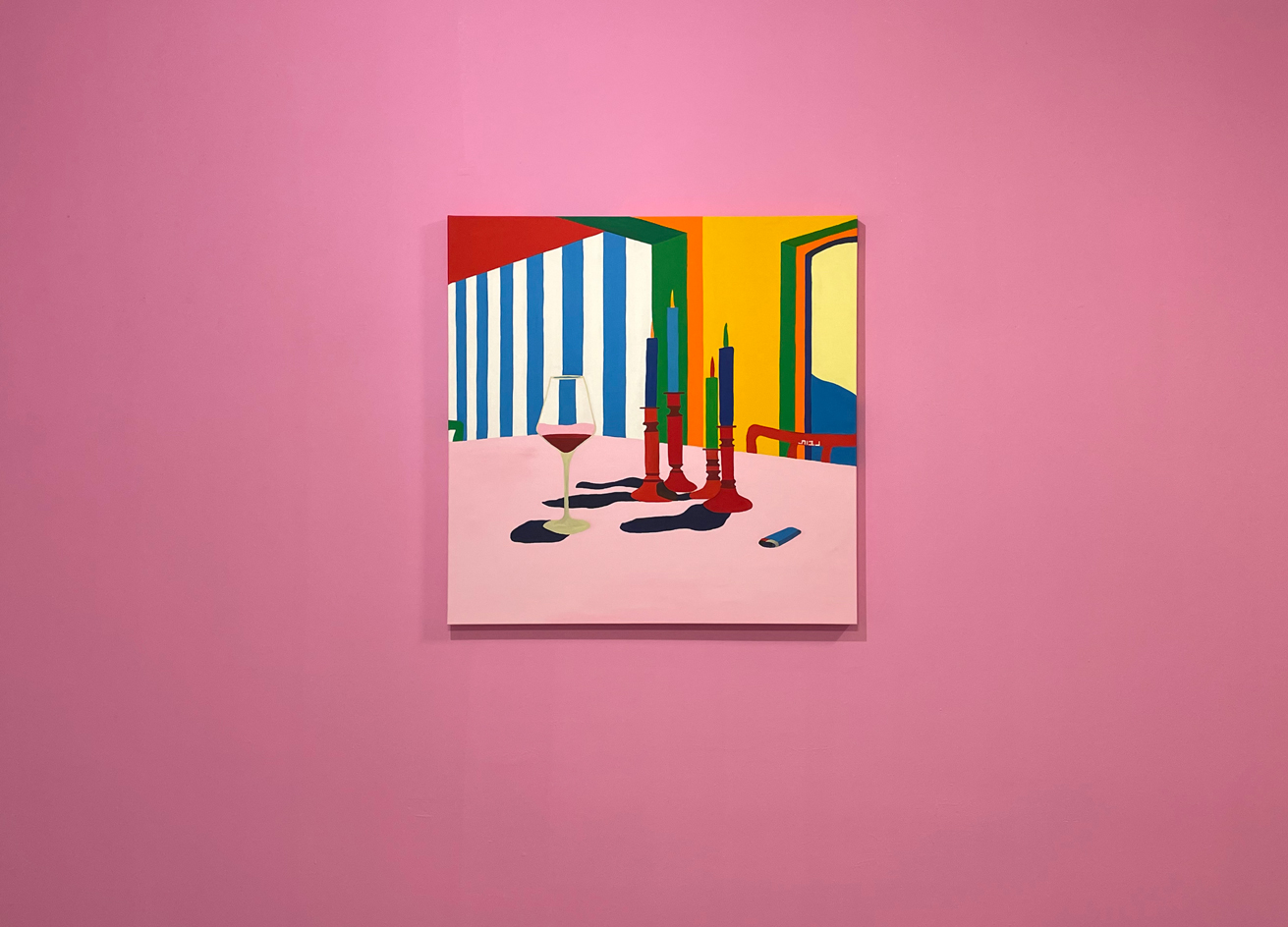
Installation view of 'Coming Back Homo', by Navot Miller. Courtesy of the artist and 1969 Gallery
W*: You've spoken about the importance of supporting emerging artists in the past. Are there particular incidences of artists whose careers you’ve been able to nurture, or long-time relationships with people you discovered when they were up and coming?
RT: Through Talk Art, I’m privileged to have been in a position to meet artists who are on the cusp of incredible, exciting moments, like Salman Toor. When the Talk Art book came out, we were doing a piece for The New York Times, and they observed us doing a podcast with him. At that time, he was just about to open at the Whitney, and that was his game-changing moment. Now he’s soaring. To know that you’re one of many cogs in this is an absolute privilege.
When I first got into art, when I was really young, I looked to Pop artists like [Roy] Lichtenstein, Keith Haring, and Andy Warhol, but they’d all died. I'd look at a picture of Andy Warhol's Factory and wish I could be part of that. Talk Art has made me realise that I could be part of today’s Warhol Factory – I can go into artists’ studios and be part of their conversations. I’m able to fangirl, and be around history.
There are many people who now come to me for art advice, and I always say to them, that you should be finding emerging artists you love. When you buy their work, you’re paying for their studio fees for that month, you’re buying materials, you're paying for their canvases, or whatever it is their medium is, and you can grow with them. There’s nothing more satisfying than being there, being a friend, and watching what happens. It’s the most wonderful thing.
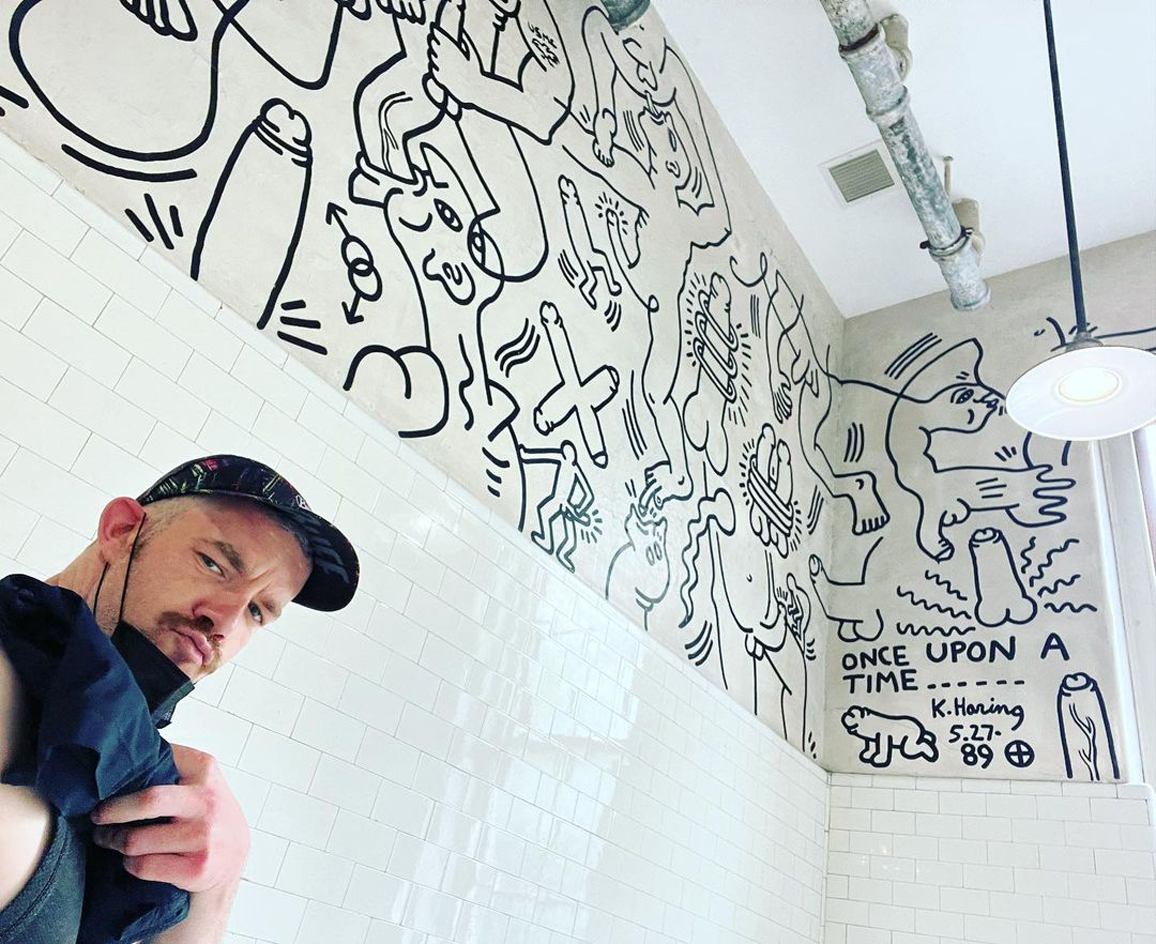
Tovey pictured with a wall piece by Keith Haring
W*: You’ve also been a notable champion of queer artists, for instance through the group show ‘My Reflection of You’ at The Perimeter, and through your work with Navot Miller. What was the first queer artwork you collected? And how has the appreciation for queer art grown in the years you’ve been in the art world?
RT: The first queer artist that I fell in love with was Wolfgang Tillmans. I was introduced to his work when I was around 22, and I was completely obsessed. There was one work in particular that I’ve always coveted, called Sportflecken (1996), which shows some dubious staining on a white t-shirt. You project your own story on Wolfgang’s works and facilitate your own dreams and fantasies. As a queer person, seeing yourself represented in photography in that way is incredibly important.
Queer art was once seen as separate from the mainstream. What’s been incredible in the last four years is that queer art, and art by minoritised communities, has come up front. Seeing queer characters interact in figurative painting, photography, and sculpture has been exciting. At the same time, queer art is commanding big prices in the auction market, and that’s trickling down. It’s no longer just ‘I’m a queer collector, so I’m going to collect queer art.’ It’s more like, ‘I’m a collector and I want to collect the best art. I want to have art that shows me what the world is, and what it can be.’ The change has been phenomenal.

Tovey is pictured with Talk Art: Everything You Wanted to Know about Contemporary Art But Were Afraid to Ask, co-authored with Robert Diament, which came out in 2021 following the meteoric success of their podcast of the same name
W*: Has it been a priority from the start for Talk Art to champion emerging artists and queer artists?
RT: We decided to make a show that was as diverse and international as possible, and was representative of many opinions and voices. We talk to both established and emerging artists. People come to Talk Art from different angles – someone may come to the show for Jeff Koons, and then stick around and find Navot Miller. Some people are coming because they’re obsessed with Tracey Emin. Others because they’ve discovered Louis Fratino. And they will stay because there’s so much to discover.
W*: There have been 13 seasons of Talk Art to date. Are there still dream guests you haven’t yet talked to? Dream combinations that you’d like to bring together?
RT: There’s a wish list of superstar artists that we would love to converge with: including David Hockney, Marlene Dumas, and Nicole Eisenman. But there’s our love of the emerging too. We’re constantly looking for and finding new voices that are changing the game, that are saying something different. I would love to do a whole season on gallery directors, where we’d go and talk to David Zwirner, and then to an emerging gallery director.
It’s gratifying to get an endorsement from a major figure in the art world. But when my mum, who listens to every episode, texts me afterwards and goes, ‘I liked that’, and then goes and finds something online, or buys, that’s an indication we’re doing our job. Because Talk Art is for people who feel not invited to the art party, and we’re going, ‘no, here’s a side door. You just need to be willing to listen and see.’
You have to remember that artists don’t make art just so rich people can buy it and put it on their walls. They want to communicate their message to as many people as possible. So you shouldn’t feel intimidated in museums and commercial gallery spaces – the artists want you to be there. They want you to know who they are, and to connect with them.
A post shared by Russelltovey (@russelltovey)
A photo posted by on
Tovey is pictured with Talk Art co-host Robert Diament (left), and Sonia Boyce (centre) shortly after the British artist was awarded the Golden Lion at the 59th Venice Biennale
W*: Lowering the barriers of entry to the art world and reframing art as something that is accessible to the general public has been key to the success of Talk Art. Does it also motivate your curatorial approach?
RT: When it comes to group shows, my approach is a lot of emerging art; artists who I just want more people to be aware of. The first show I curated was at Carl Freedman Gallery in Margate, called ‘Breakfast under the Tree’. I went to all these artists and asked them to make works inspired by Manet’s Le Déjeuner sur l'herbe (1863). It was artists that a lot of people at the time hadn’t heard of. The show was delayed by the pandemic, but when it finally opened a year and a half later, some of these artists had become superstars: Toyin Ojih Odutola, Doron Langberg, Salman Toor. The opportunity to do that now with these artists just wouldn't exist, because there's no way that they had space in their schedules.
It’s exciting to work with emerging artists, and then see where they go and what happens. It gives me a proud dad moment to know that I might have had a tiny influence on where an artist’s career could go.

Tovey holds a work by Israeli-born, Brooklyn-based painter Doron Langberg
W* What is your dream curatorial assignment?
RT: I would love to do a show of historical queer art. A lot of artists who died of AIDS have been overlooked. Some, like Derek Jarman, are now being rediscovered, but many still haven’t been. I did a show at David Zwirner in Paris on Hugh Steers. And I’m making a documentary at the moment on David Robilliard, who is my ultimate hero. He was a poet-artist, and I always select his poetry when I’m asked to do readings. There's something fascinating in making sure that the gaps in our history are filled.
W*: What is your favourite art institution in the world, and why?
RT: It would probably be the Peggy Guggenheim Museum in Venice. It’s her former home, an incredible building right on the water. She apparently bought a painting a day – if I could do that, I probably would! As a collector, being able to walk around someone’s art collection in their private residence is always a major treat. So there’s nothing more satisfying than going into her house and seeing the most incredible Picassos and Dalís and Ernsts, and learning about her stories. It’s a special, powerful, palpable place because I relate to her addiction to art.
I'm obviously a dog fanatic; I love my dogs, Rocky, Cooper and Archie. Peggy Guggenheim was a dog fanatic as well. There’s a little pet cemetery at the museum, and all her dogs have these little headstones with their names. That kind of affinity for animals, that absolute respect for an animal’s life – to give them a proper burial, and a real sense that they existed – is incredibly moving. The whole place is always an amazing experience.
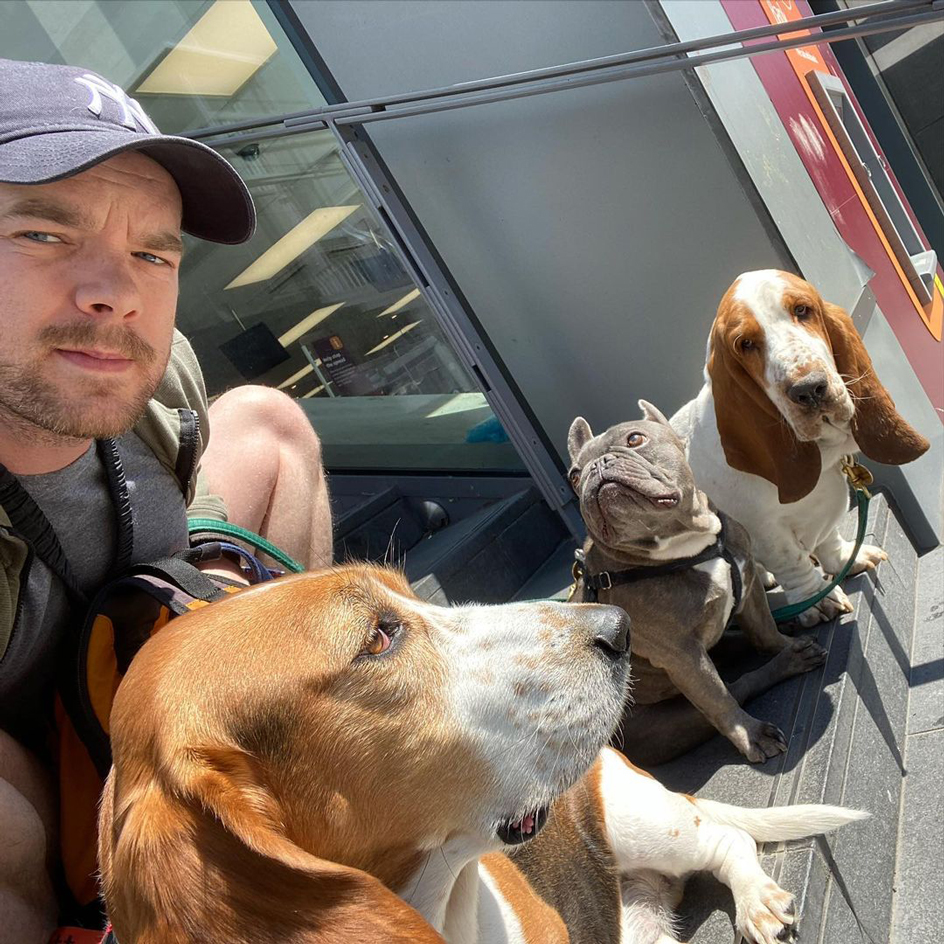
Tovey is pictured with his dogs Cooper, Rocky and Archie
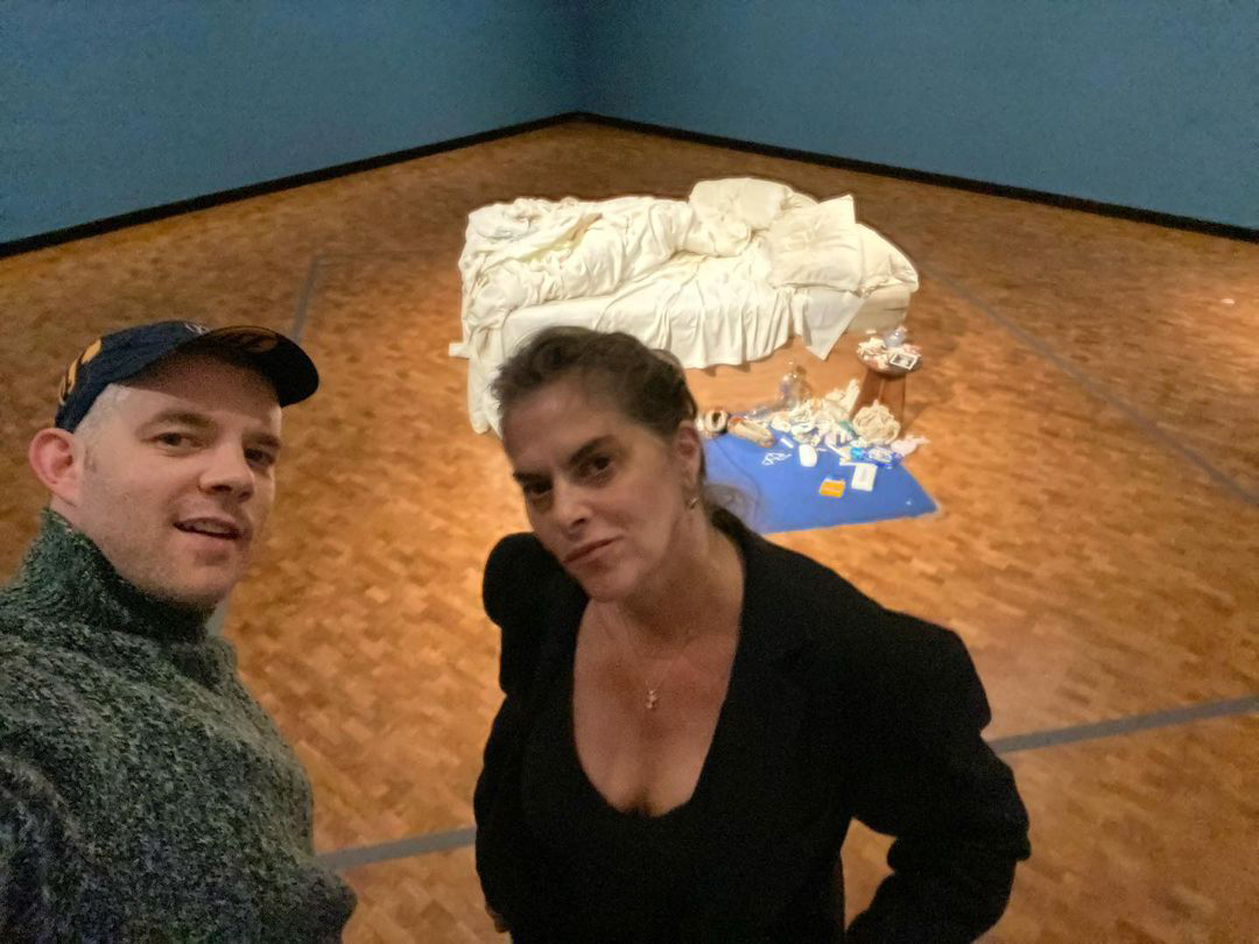
Tovey and Tracey Emin stand in front of Emin's iconic work, My Bed (1998)
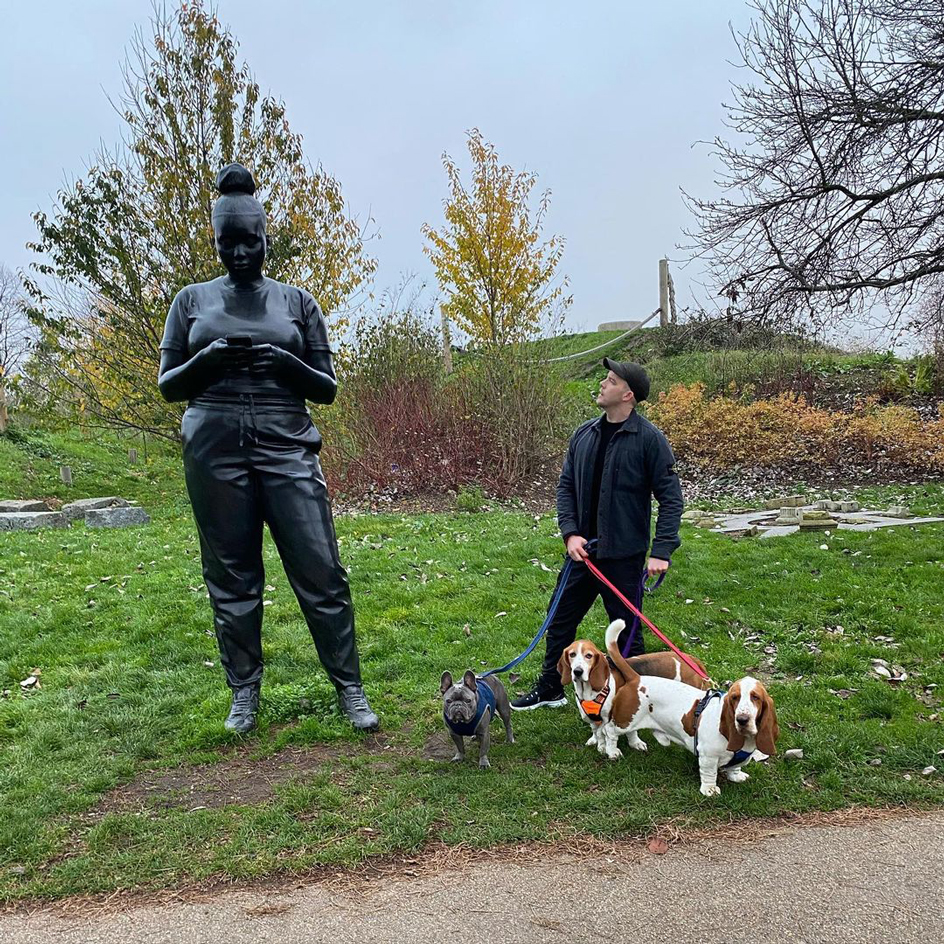
Tovey and his three dogs stand next to a sculpture by artist Thomas J Price
INFORMATION
‘Navot Miller: Coming Back Homo’, curated by Russell Tovey, until 28 July 2022, 1969 Gallery, 103 Allen Street, Lower East Side, New York, 1969gallery.com
TF Chan is a former editor of Wallpaper* (2020-23), where he was responsible for the monthly print magazine, planning, commissioning, editing and writing long-lead content across all pillars. He also played a leading role in multi-channel editorial franchises, such as Wallpaper’s annual Design Awards, Guest Editor takeovers and Next Generation series. He aims to create world-class, visually-driven content while championing diversity, international representation and social impact. TF joined Wallpaper* as an intern in January 2013, and served as its commissioning editor from 2017-20, winning a 30 under 30 New Talent Award from the Professional Publishers’ Association. Born and raised in Hong Kong, he holds an undergraduate degree in history from Princeton University.
-
 Europe’s auto industry regroups at the Brussels Motor Show: what’s new and notable for 2026
Europe’s auto industry regroups at the Brussels Motor Show: what’s new and notable for 20262026’s 102nd Brussels Motor Show played host to a number of new cars and concepts, catapulting this lesser-known expo into our sightlines
-
 Wallpaper* Best Use of Material 2026: Beit Bin Nouh, Saudi Arabia, by Shahira Fahmy
Wallpaper* Best Use of Material 2026: Beit Bin Nouh, Saudi Arabia, by Shahira FahmyBeit Bin Nouh by Shahira Fahmy is a captivating rebirth of a traditional mud brick home in AlUla, Saudi Arabia - which won it a place in our trio of Best Use of Material winners at the Wallpaper* Design Awards 2026
-
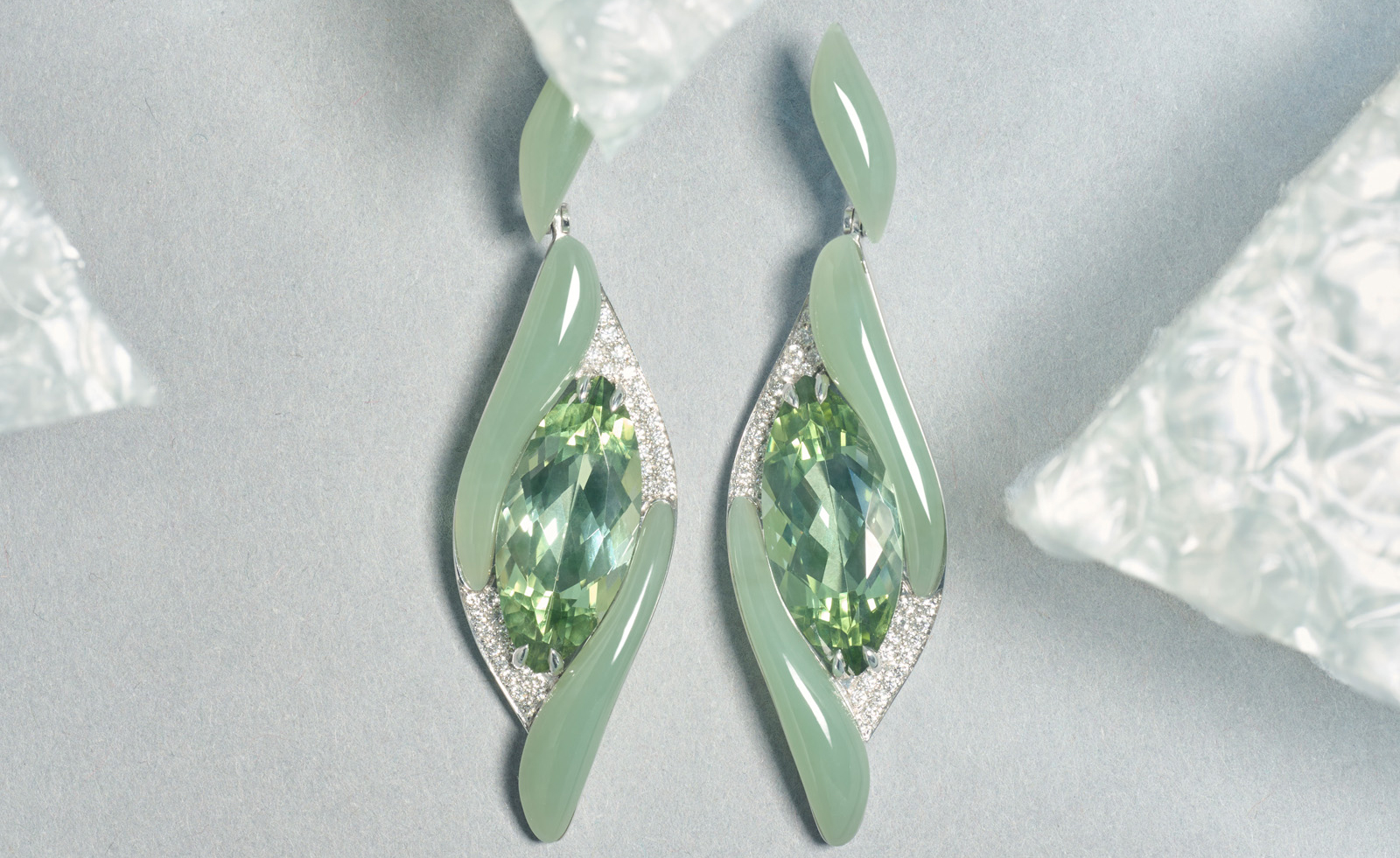 Wallpaper* Design Awards: Boghossian’s gem wizardry dazzles in high jewellery
Wallpaper* Design Awards: Boghossian’s gem wizardry dazzles in high jewelleryBoghossian's unique mix of craftsmanship and modern design is behind the edgy elegance of its jewellery – a worthy Wallpaper* Design Awards 2026 winner
-
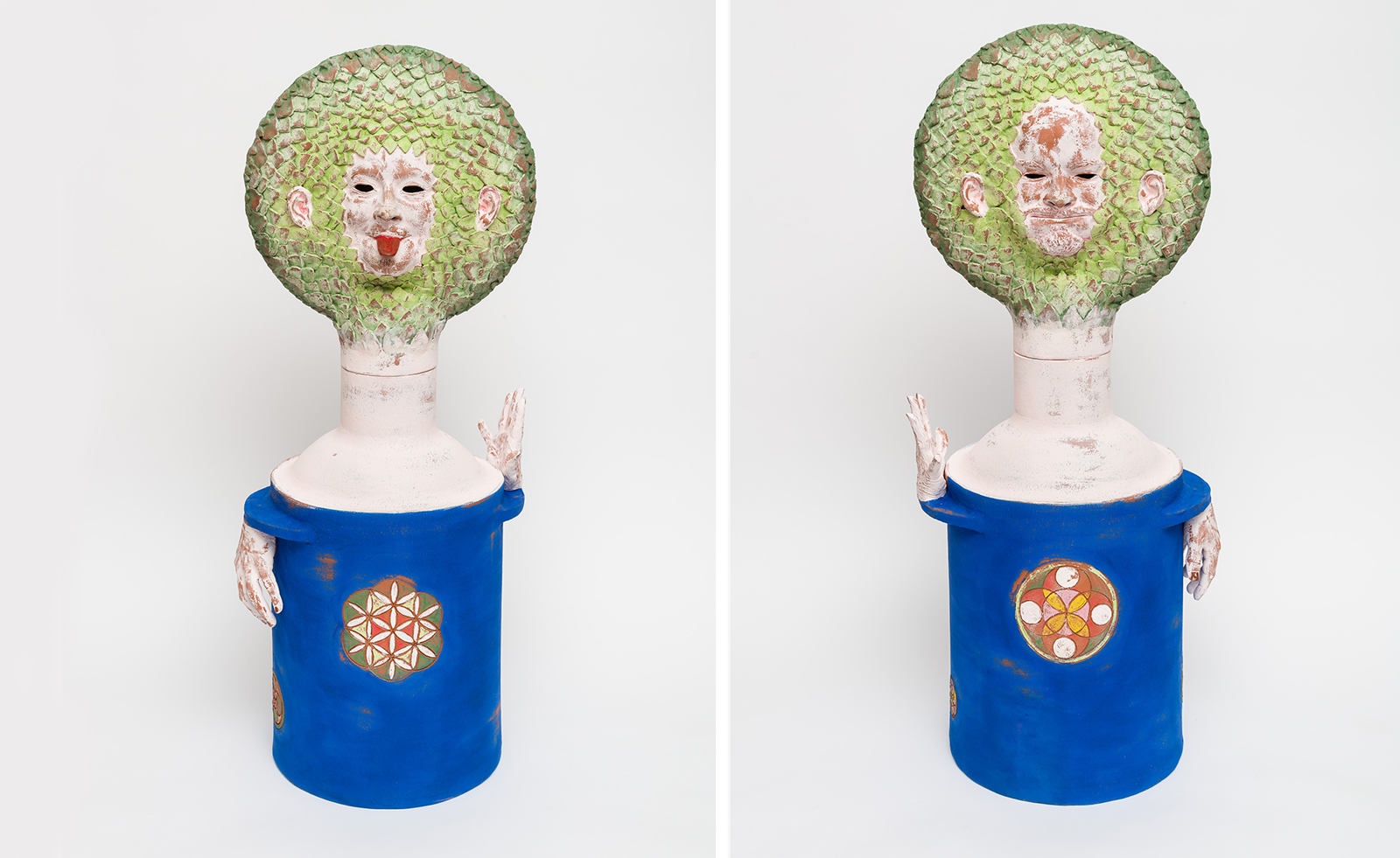 Ceramic artists: top trail-glazers breaking the mould
Ceramic artists: top trail-glazers breaking the mouldA way with clay: discover the contemporary ceramic artists firing up a new age for the medium
-
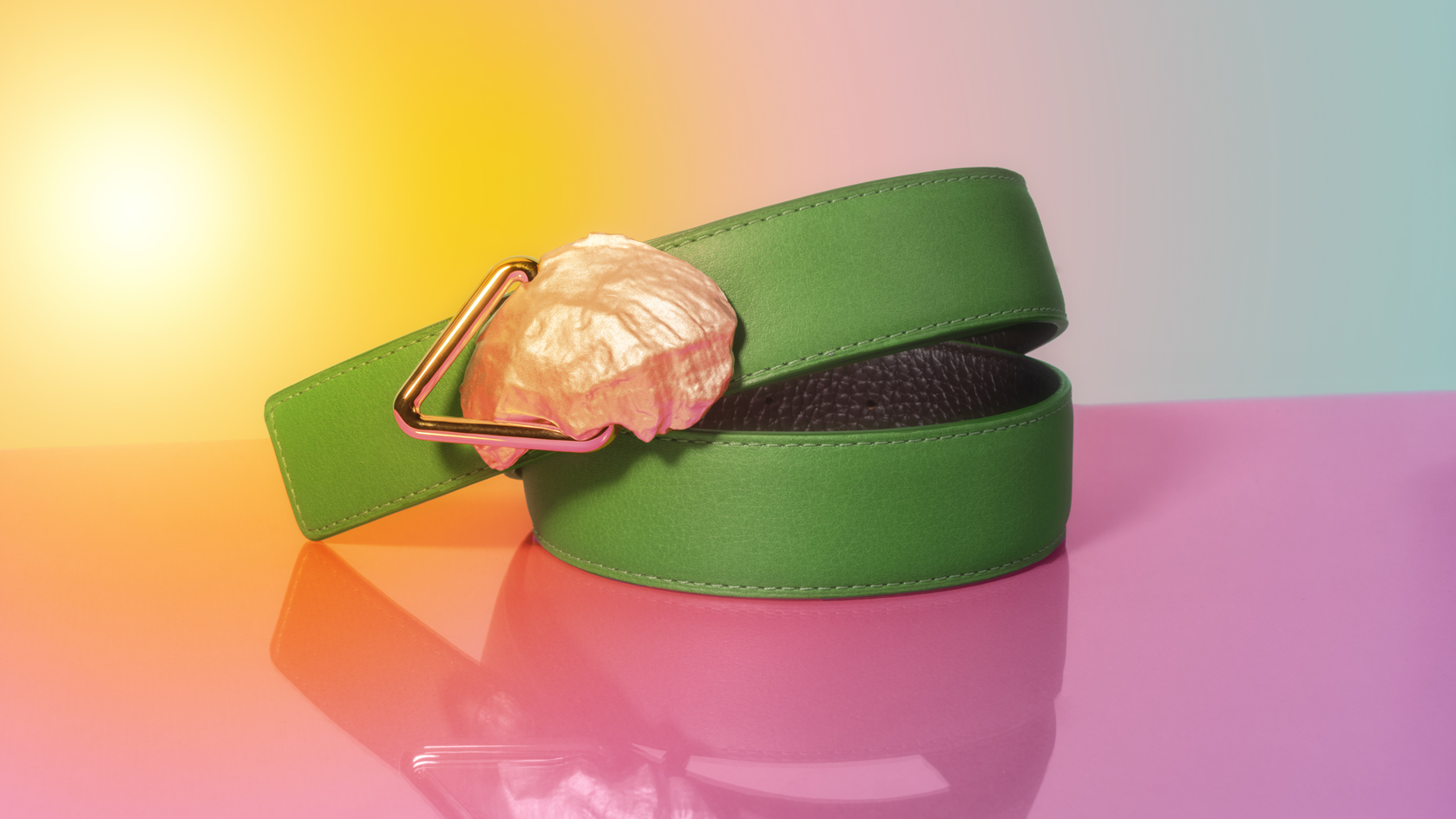 The best art gifts for the creative in your life
The best art gifts for the creative in your lifeGet inspired with our ongoing guide to the best art gifts
-
 10 best art exhibitions to see in 2023, picked by Wallpaper* arts editor Harriet Lloyd-Smith
10 best art exhibitions to see in 2023, picked by Wallpaper* arts editor Harriet Lloyd-SmithTo usher in the new year, Wallpaper’s arts editor Harriet Lloyd-Smith highlights the best art exhibitions to see in 2023, and there’s a lot to look forward to
-
 Veronica Ryan wins the 2022 Turner Prize
Veronica Ryan wins the 2022 Turner PrizeVeronica Ryan, the artist who honoured the Windrush generation, has been named winner of the 2022 Turner Prize in a ceremony held in Liverpool
-
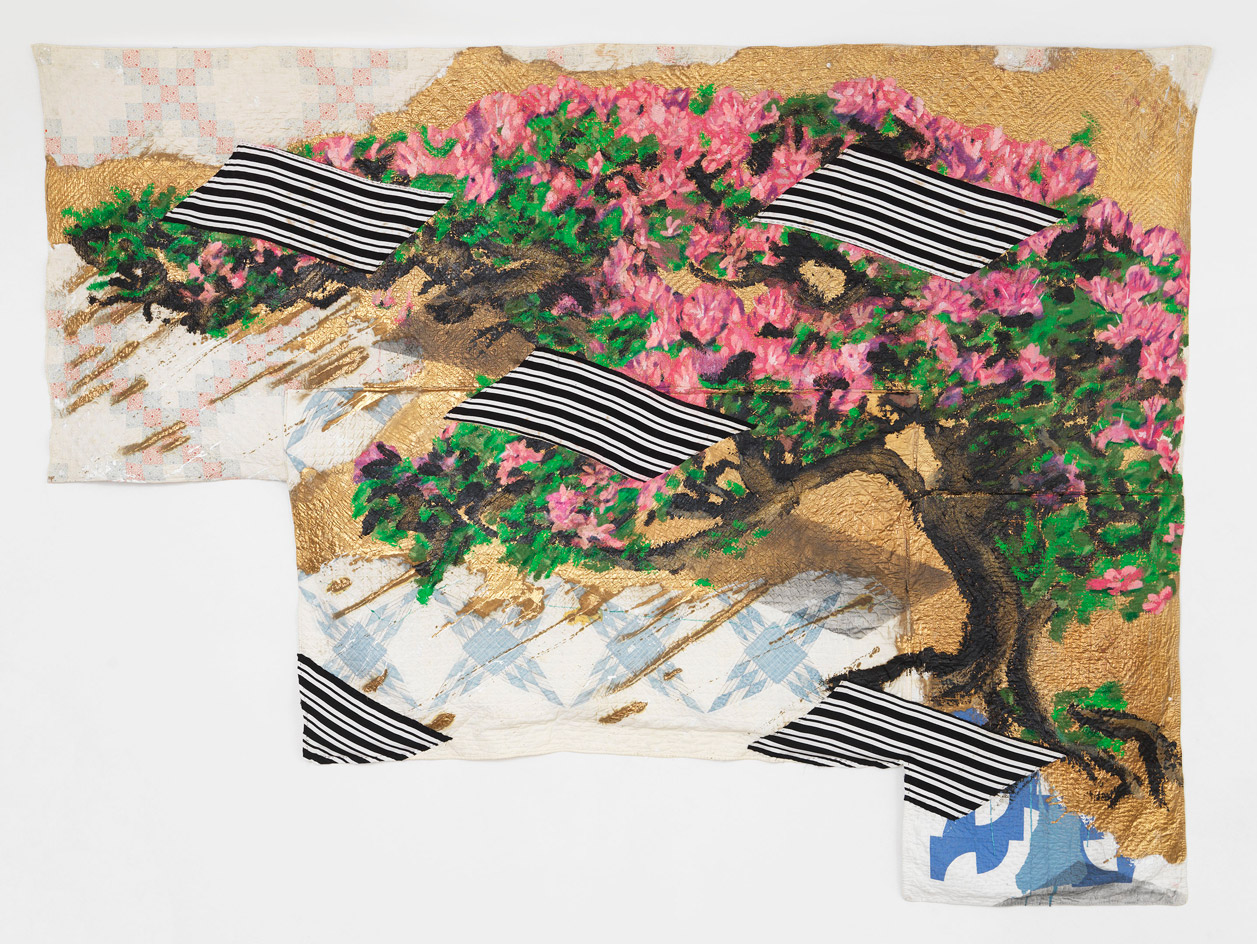 Textile artists: the pioneers of a new material world
Textile artists: the pioneers of a new material worldThese contemporary textile artists are weaving together the rich tapestry of fibre art in new ways
-
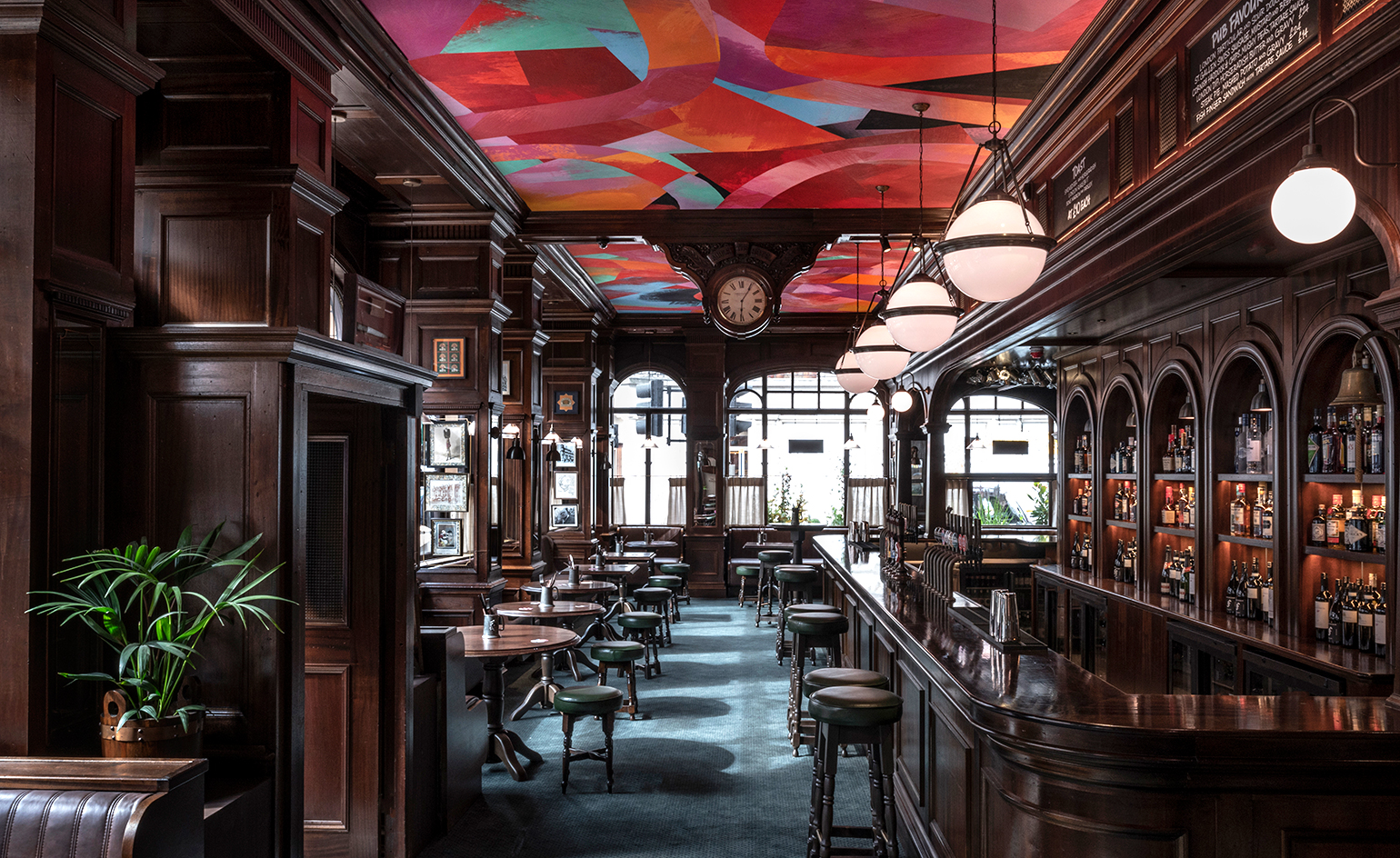 The Audley: a first look inside Artfarm’s new art-filled Mayfair pub
The Audley: a first look inside Artfarm’s new art-filled Mayfair pubFor its first London project, hospitality company Artfarm has given new life to the 18th-century Audley Public House which opens today in Mayfair. We offer a first look inside the new pub, which is a hub for history, community, hospitality and world-class contemporary art
-
 At home with Daniel Arsham
At home with Daniel ArshamSpeaking from New York, prolific pan-creative Daniel Arsham discusses dream collaborators, Star Wars, and advice for the next generation, and shares images of his work, travels and home on Long Island
-
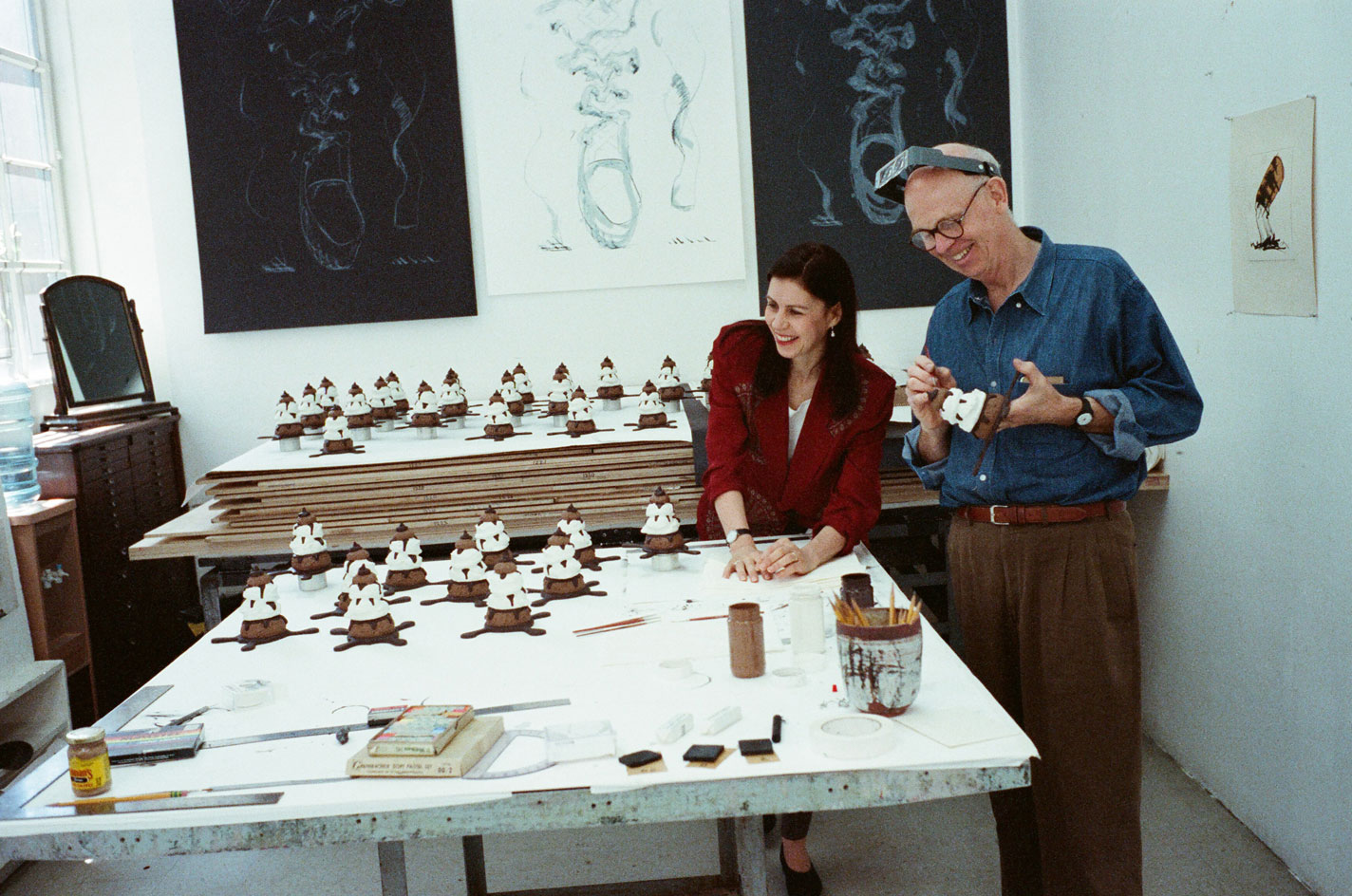 The dynamic duet of Claes Oldenburg and Coosje van Bruggen
The dynamic duet of Claes Oldenburg and Coosje van BruggenRemembering Claes Oldenburg, who died aged 93 on 18 July 2022, we revisit our 2021 article celebrating his partnership with Coosje van Bruggen, as the duo’s final work together, Dropped Bouquet, was realised and exhibited at Pace New York’s ‘Claes & Coosje: A Duet’